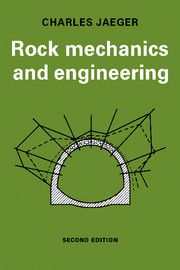Book contents
- Frontmatter
- Contents
- Preface
- Preface to the first edition
- Part 1 Introduction to rock mechanics
- Part 2 Rock material and rock masses
- Part 3 Rock mechanics and engineering
- 9 Rock slopes and rock slides
- 10 Galleries, tunnels, mines and underground excavations
- 11 Rock mechanics and dam foundations
- Part 4 Case histories
- References
- Appendix 1 Comments on the bibliography
- Appendix 2 Measurement conversion tables
- Appendix 3 Table of geological formations and earth history
- Appendix 4 Some petrographic properties of rocks
- Author Index
- Index of geographical names, dam sites, reservoirs, tunnels and caverns
- Subject Index
9 - Rock slopes and rock slides
Published online by Cambridge University Press: 04 August 2010
- Frontmatter
- Contents
- Preface
- Preface to the first edition
- Part 1 Introduction to rock mechanics
- Part 2 Rock material and rock masses
- Part 3 Rock mechanics and engineering
- 9 Rock slopes and rock slides
- 10 Galleries, tunnels, mines and underground excavations
- 11 Rock mechanics and dam foundations
- Part 4 Case histories
- References
- Appendix 1 Comments on the bibliography
- Appendix 2 Measurement conversion tables
- Appendix 3 Table of geological formations and earth history
- Appendix 4 Some petrographic properties of rocks
- Author Index
- Index of geographical names, dam sites, reservoirs, tunnels and caverns
- Subject Index
Summary
Any mention of rock slopes and rock slides should include the remarkable paper published in 1932 by A. Heim. He systematically describes and analyses, as a geologist, all slides known to him and classifies them into over twenty types. One of his more important findings concerns the distinction between slowly progressing slides, where conditions of stability are only slightly disturbed and the very rapidly accelerating slides where concentrated energy and momentum cause rock masses to reach exceedingly high velocities.
His analysis of the geological cause for rock imbalance which starts slides, like weakening and aging of rock masses, water percolation, springs and the action of man, brings him no nearer to the true mechanics of a slide. This is not a geological problem but one of rock statics and dynamics.
Stability of slopes, superficial rock falls and deep-seated lines of rupture will be dealt with in this chapter. The complex dynamics of accelerated discontinuous rock slides will be illustrated in chapter 14, statics of rock faces will be analysed more closely in chapter 15.
Terzaghi (1962b) has published an interesting paper called ‘Stability of steep slopes …’ after many years of research. Essays by Stini, Müller and others have produced additional information, but the necessity for a more reasoned analysis of the problems of statics and dynamics became apparent after the Vajont rock slide. Terzaghi suggests that rock slopes should be classified by the type of rock, the analysis of the mechanisms of rupture, the action of water in the pores, fissures and cracks.
- Type
- Chapter
- Information
- Rock Mechanics and Engineering , pp. 203 - 225Publisher: Cambridge University PressPrint publication year: 1979



